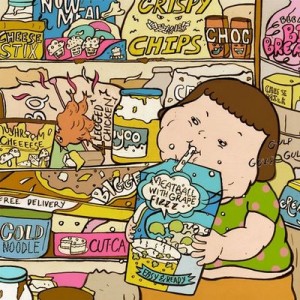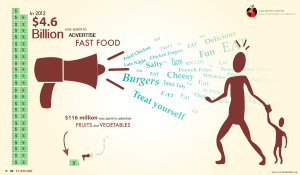We trust what we are putting in our body because anything unhealthy, sanitized or even deathly would obviously be break a lot of rules in the food industry and would be stopped by the government, right? Of course, There are tons of strict regulations that protect what we are eating and how its produced? Nope. The Government and Food Industry aren’t as trust worthy as we hope to believe.
The food industry has changed tremendously in the last 60 years. From farms, local and small companies to large, corrupt corporations that mass produces chemically enhanced foods. Our country has no clue what is happening behind the mouth watering meats and healthy looking vegetables. Even sometimes “organic foods” are misleading and most people don’t even want to know.
Each year, over 70 million people are effected by a food borne illness, and this number is just rising. Even young children are being affected by this harmful diseases. Robert Kenner, Food Inc. introduces the story of Kevin Kowalcyk, a young boy who died after eating only one hamburger on his way home from vacation. For years, Kevin’s mother and family has shared their story and fought the food industry’s to pass important regulation laws but it continues to be a constant battle. You would think the death of an innocent child would be enough to stop these food companies from sliding through regulations.
In one of the strongest industry’s, shouldn’t the government, medical world and corporations be heavily involved in stopping these food borne illness’s? Food companies don’t even have to have a recall a product they know is causing sickness, but many do just for the image. Its very uncommon that the government and even doctors step in unless hundreds get ill or there are multiple deaths. Mostly because its too much effort to have evidence that a certain food caused a death. Marion Nestle, author of Food Politics, and Professor of Nutrition, Food Studies and Public Health at NYU, states “USDA has 7,000 inspectors or so, and they over see 6,000 meat, poultry and egg establishments and 130 importers that slaughter and process 89 million pigs, 37 million cattle and 7 billion chickens and turkeys, not to mention the 25 billion pounds of been and 7 billion pounds of ground beef each year… The demands on the FDA are even more unreasonable. About 700 FDA inspectors must oversee 30,000 food manufacturers and processors, 10,000 warehouses, 785,000 commercial and institutional food establishments, 128,000 grocery and convenience stores, and 1.5 million vending operations.” We hope that professionals, like food inspectors are making sure these companies aren’t getting away with unhealthy and harmful practices of food processing, but we can’t when we don’t even have enough of them to go around.
Food Inc., an extremely effective way of opening the world to the corrupt and unhealthy food industry, takes the viewer right to the source, showing the conditions these animals are living in. They are packed into small, tight, feces ridden dark shacks, eating pounds of chemically packed foods, which leads straight to where we don’t want them; our bodies. Many don’t think or care about what the animals are eating, but according to Consumer Reports, You are What They Eat. Cows, are being fed corn which creates a fatter cow and more beef which yes, may save money for the company and farmers, but packs the animals with bacteria. This bacteria is extremely harmful to not only their bodies but then to us. The bacteria found in their feces are often mixed in to our meat supply because of the busy and over packed slaughter houses. These cows should be fed what nature made them to eat, grass, And only grass.
It isn’t only the animals being treated poorly but the workers as well. Carole, a farmer introduced in Food Inc, states, “Having no say in your business is degrading, its like you are a slave to the company.” These large corporations break many labor and job laws as well, overworking their employees in harmful and unhealthy conditions. Robert Kenner and his film Food Inc, opens our eyes to way the food industry takes over everything, “It looks like there is diversity in supermarkets but its really just a few companies” Journalist, Michael Pollen states making us realize what we thought of as small, local and healthy brands are owned by huge corporations like Kellogg, Tyson, and Pepsi. Michael Pollen also speaks about the harmful and genetically modified foods we are eating “There is no seasons in the American supermarket. Now there are tomatoes all year round, grown halfway around the world, picked when it was green, and ripened with ethylene gas. Although it looks like a tomato, its kind of a notional tomato. I mean it’s the idea of a tomato” Yes, maybe it is nice to be able to eat your favorite fruit or vegetable all year round, but it is anything but natural.
Organic Illusions, written by Blake Hurst shines a light on the organic food industry as well. Although Organic foods are the better path to take, its still hard to trust a company that we don’t know much about. “Organic foods are labeled as organic because producers certify that they’ve followed organic procedures. No testing is done to check the veracity of these claims.” Although Hurst does not provide much evidence about these problems and the studies included had little numbers and dates, it still gets the job done of making the public question what we are putting inside our bodies.
Knowing the harmful qualities of the food you are eating, and the lack of regulation among he food industry, do you feel the need to change the way you go about finding the right food? You should. In order to stop these companies from taking over this country and to decrease the number of deaths from food borne illness, the majority has to take a stand and not support the corruption happening in the industry.
Reflection Questions
- Describe your understanding of the “writer’s project”? How were you able to identify the texts’ “project”? Discuss your own “project” as it pertains to this particular blog article.
The writers project was very helpful in the process of writing my own blog post. Looking at each text, I asked myself, “What are they trying to do?” and “What are they using to do this.” My Writing project is similar to the texts we read in class, which was to make the reader question what they were eating. I used evidence and excerpts from multiple texts to show my knowledge on the subject from reading these multiple articles and to back up my statements.
- Describe your completion of the “Sorting it Out” workshop? What sections were most beneficial to the development of your ideas—and why? Discuss how this workshop assisted in development of draft and/or assignment organization?
“Sorting it out” was very helpful, in well, Sorting it all out. After reading multiple texts over the unit, it was helpful to go back and find the specific and important main things that made up the article. It was able to clear up and distinguish each article from its own and was very helpful when it came to writing about each text in my blog post.
- Describe your understanding of synthesis. What is its importance? How did it manifest within your drafts and/or final blog article? Provide examples.
Synthesis is the combining of multiple ideas and elements to make up a theory. This was important to think about when working with multiple texts, like Food Inc., organic Illusions, Food Politics etc. It was hard at first to be able to synthesize so many ideas into one article but I feel like I was successful by the final.
- Describe your own accomplishment (ofsomething) during this unit.
I believe my strength in my blog post was how I was able to swiftly move from one example from a text to another. I feel like sometimes It can be awkward to read a quote from one article and move to another example but I think I did well at making it clear and natural.
- Discuss the evolution of the main idea. Where did you begin (include the example) and show its progress (again, include example) throughout the drafting/revision process. To what do you attribute its evolution?
My main idea was talking about the text and their writing projects, I talked about what each article did well at and why. Throughout the drafts I added more specific information from each article so the reader was learning things about the food industry and not the articles themselves.
- Discuss what organizational strategies you implemented in order to structure this blog article. Provide examples from a section(s) of an earlier draft and other excerpts in later drafts to support your response.
Looking back I noticed the evolution of my closing. Have always had trouble with closing statements and have a habit of ending my papers on a quick and unfinished note. My first draft I ended with talking about organic illusions, “Although Hurst does not provide much evidence about these problems and the studies included had little numbers and dates, it still gets the job done of making the public question what we are putting inside our bodies.” I then added on and used a full closing statement to sum up the post “Knowing the harmful qualities of the food you are eating, and the lack of regulation among he food industry, do you feel the need to change the way you go about finding the right food? You should. In order to stop these companies from taking over this country and to decrease the number of deaths from food borne illness, the majority has to take a stand and not support the corruption happening in the industry.”
- Provide an example of the final draft where you successfully synthesize 3 texts in a concise and direct manner. Discuss how this evolved throughout the drafting process for you.
I think this was a strong use of synthesis. “Food Inc., an extremely effective way of opening the world to the corrupt and unhealthy food industry, takes the viewer right to the source, showing the conditions these animals are living in. They are packed into small, tight, feces ridden dark shacks, eating pounds of chemically packed foods, which leads straight to where we don’t want them; our bodies. Many don’t think or care about what the animals are eating, but according to Consumer Reports, You are What they eat.” I then move into talking about the Consumer Reports article.
- Discuss the evolution of the ‘lede’ in earlier drafts and its final version (provide examples of each): where did you begin, what feedback did you receive, and how did it end up in final blog article?
I cannot find my original draft with my opening but I do know My lede evolved tremendously. Before doing the lede workshop my opening wasn’t as strong and captivating. It was very wordy and boring. I believe using questions in my lede, make you want to keep reading.
- Name a specific writing/researching/revision goal you’d like to work on during the next Unit projects.
I think I need to work on diving deeper into information. I tend to stay pretty specific and stick getting the message across instead of developing and giving lots of information on a certain topic. I think its important to be able to dive deeper, especially on research articles.







